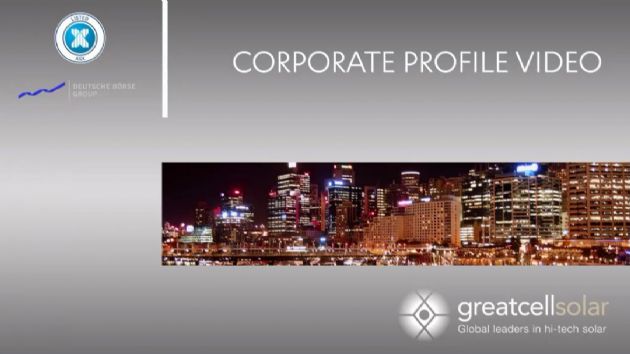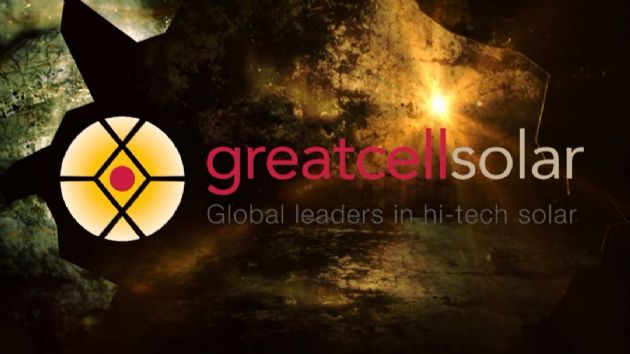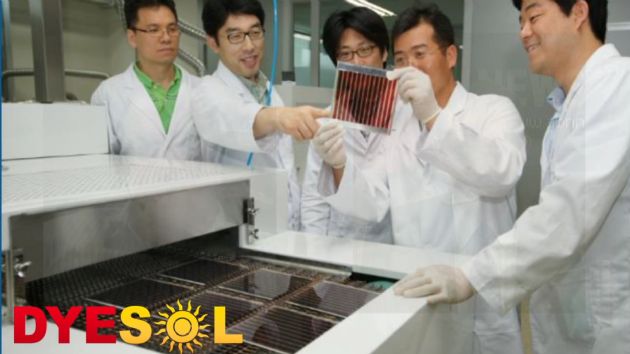 Fourth Quarter FY 2016 - Quarterly Report and Appendix 4C
Fourth Quarter FY 2016 - Quarterly Report and Appendix 4C
Sydney, July 28, 2016 AEST (ABN Newswire) - Dyesol Limited ( ASX:DYE) are pleased to provide the Company's Quarterly Report and Appendix 4C for the period ending 30 June 2016.
ASX:DYE) are pleased to provide the Company's Quarterly Report and Appendix 4C for the period ending 30 June 2016.
Financial Quarter Highlights
- Turkey Commercialisation Setback Not Considered Terminal
- TAB Quarterly Milestone of 13% Porous Carbon Strip Cells Achieved
- Cristal/Dyesol Jointly File Performance Enhancing, Doped TiO2 Patent
- VDL ETG Prototype Collaboration On Track
Corporate and Operational
We awoke on the morning of Saturday, July 16 to the shocking news that there had been an attempted, and ultimately unsuccessful, coup d'état in Turkey. No direct loss was incurred by Dyesol because of the events as prudent risk management is always a key consideration in addressing international opportunities. Prior to this event, progress was very encouraging with Dyesol addressing each due diligence step professionally and receiving regular and positive feedback from government and our business associates there. When order is fully restored we expect our project to be again favourably considered for substantial financial government assistance.
It also is worth reminding ourselves that there are many billions of dollars of foreign investment in Turkey and it is critical to retain this investment and encourage further investment for its future growth and prosperity, especially in the energy sector. The Turkish government is currently sending strong messages to the international investment community emphasising its commitment to democracy and free markets. For latest examples, please see http://www.invest.gov.tr
During and subsequent to the recent Australian federal elections, we have enjoyed constructive discussions with both CSIRO and ARENA at the highest level. Most apparent is the willingness to have government and industry working in an accountable and coordinated way to achieve more focused, commercial results. It appears the best outlook for energy renewables in Australia for several years.
Away from elections and geopolitics, Dyesol is performing very well. Recently, internal audits of R&D activities have confirmed progress and given confidence that allows us to move to scaling activities. Rigorous FY2017 budgets have now been completed and approved by the board. Importantly, and in response to very tight fiscal controls, corporate spend continues to fall, whilst the significant remainder is almost exclusively focused on achieving IEC61646 at module and panel scale, internally and with the external driver of the MAD project in collaboration with VDL ETG.
The International Conference on Hybrid and Organic Photovoltaics (HOPV16) was held over 3 full days at the beginning of July in Swansea, U.K. This is the most important gathering in the international scientific and business community on PSC PV. Dyesol was a lead sponsor and our attendance was to promote our product and equipment sales, rather than share our scientific and commercial advantage.
At the conclusion of the financial year, Dyesol again grew its sales by more than 25% and is now quite dominant in its market share of research grade materials and equipment to the global PSC community. We expect further improvement and profitability for this important revenue activity during FY2017, independently of outcomes with Nesli in Turkey.
Research and Development
Internal audits, reviews, gap analysis and adherence to technical milestone schedules help ensure that progress is meaningful and closely tied to our commercial objectives. Our work with ARENA on Levelised Cost of Electricity (LCOE) is an excellent 3rd party validation of the quality of our plans and goals.
Taking ourselves back 3 years with the rapid emergence of PSC, our shareholders will remember that we have focused on architectures that are stable and durable. Essentially, this means architectures that have little or no organics, are able to be environmentally encapsulated and sealed and where costs are contained and industrial conversion efficiencies competitive. This clearly distinguishes us from the academic community. We have been running parallel programmes in 2 strong candidate architectures and are delighted to announce this week that we have achieved our Technical Advisory Board milestone of 13% conversion efficiency at the strip cell level for Porous Carbon based PSC. The quality of the development work that underpins this is high with very low sample variation and "hero" performance of 13.6%. We also believe this is a world record for Porous Carbon PSC at 1cm2. This is very significant as it provides high confidence of translation of performance into larger devices where competitive LCOEs can be achieved. This is very significant as it provides high confidence of translation of performance into larger devices where competitive LCOEs can be achieved. Over the next few months we will be using this excellent progress to commence the stability testing protocols required to achieve IEC61646 certification at a module level.
External performance certification is also important. Dyesol is increasingly working with Newport Laboratories in the US and in a formal collaboration with the CSIRO, based in Newcastle. Early discussions have also commenced with the National Renewable Energy Laboratories of the United States (NREL) to agree testing protocols. Uniformity of testing methodology is far from settled, however it is transitioning from early IV testing now to Maximum Power Point Tracking (MPPT) which will help make various claims by the R&D community more real-world relevant.
On that note, we urge caution. Many ambit claims are made about laboratory achievements. Mostly they are for unstable PSC architectures or for active area performance of small cells, rather than the necessarily lower aperture or total device performance of larger modules and panels. We have little time or inclination to be policing claims, but if it looks incredible it is usually not credible.
It was also exciting to recently receive preliminary results from EPFL, where our post-doc appointee, Dr Neha Arora, achieved 15% conversion efficiency in an alternative low-organics device, opening additional pathways for industrial progress.
Under the Joint Development Agreement recently signed with Cristal in the UK, we have made a provisional patent application based on improved conversion efficiency from iodine doped mesoporous titania. Initial test results are very encouraging and we are now engaging with EPFL and 3rd party laboratories to fully quantify and substantiate the higher efficiencies achieved.
Manufacturing and Technical Collaborations
The preliminary outcomes for the VDL ETG Major Area Demonstration (MAD) prototype project are prospective. Phase 1 or Functional Specification and Feasibility is complete. It has provided confidence to proceed to Phase 2, Engineering and Design, which will be submitted to the board for approval very shortly. This phase is expected to take approximately 4 - 5 months to complete. While Phase 2 is underway, Dyesol will be working towards a scale of 650 x 450 mm internally, known as mini-MAD, as the handover point prior to full scale prototype manufacture at Phase 3, Realisation and Testing. The Process and Glass groups have been merged to facilitate this project under the supervision of Sung Il Lee. What we are achieving each day with VDL ETG is remarkable in terms of understanding the scale and scope of the project and de-risking it. Risk mitigation is a critical focus for the project.
Progress at University of Porto (UPorto) on laser assisted, low-temperature, glass frit sealing is slow, but positive. Our milestone based payment schedule is in arrears because of this, although the implications are negligible and certainly acceptable from a cash flow perspective. It will gain further impetus at the commencement of the new financial year as the GOTSolar/Horizon 2020 project commences with the catalyst of a EUR4 million parallel EU funded project where Dyesol is a lead partner along with EPFL and UPorto. This introduces the innovative sealing technology to which Dyesol has IP rights to steel substrates, as well.
Progress at Solliance is good and meeting expectations. We will now have 2 scientists located there. Activity is almost exclusively focused on the development of an inorganic hole transport material (HTM) based architecture suitable for steel substrates. We believe this is capable of delivering an important commercial competitive advantage for Dyesol.
Financials
The net operating monthly cash burn (Sec. 1.8) for the last quarter averaged $1m. Net cash usage from operating and investing activities (Sec. 1.14) for the year ending 30 June 2016, averaged $632k per month with R&D tax rebates included.
At the end of the last quarter cash balances totalled $4.6m. In September we expect an approximate $3.8 million R&D rebate from the federal government based on R&D activities approved and conducted over FY2016.
To view the report, please visit:
http://abnnewswire.net/lnk/80NE1584
About Greatcell Solar Limited
 Greatcell Solar Limited (ASX:GSL) (OTCMKTS:DYSOY) is a global leader in the development and commercialisation of Perovskite Solar Cell (PSC) technology – 3rd Generation photovoltaic technology that can be applied to glass, metal, polymers or cement. Greatcell Solar Limited manufactures and supplies high performance materials and is focussed on the successful commercialisation of PSC photovoltaics. It is a publicly listed company: Australian Securities Exchange ASX (GSL) and German Open Market (D5I). Learn more at our website and subscribe to our mailing list in English and German.
Greatcell Solar Limited (ASX:GSL) (OTCMKTS:DYSOY) is a global leader in the development and commercialisation of Perovskite Solar Cell (PSC) technology – 3rd Generation photovoltaic technology that can be applied to glass, metal, polymers or cement. Greatcell Solar Limited manufactures and supplies high performance materials and is focussed on the successful commercialisation of PSC photovoltaics. It is a publicly listed company: Australian Securities Exchange ASX (GSL) and German Open Market (D5I). Learn more at our website and subscribe to our mailing list in English and German.


![abnnewswire.com]()
Related Companies
Social Media
Share this Article

 ASX:DYE) are pleased to provide the Company's Quarterly Report and Appendix 4C for the period ending 30 June 2016.
ASX:DYE) are pleased to provide the Company's Quarterly Report and Appendix 4C for the period ending 30 June 2016.  Greatcell Solar Limited (ASX:GSL) (OTCMKTS:DYSOY) is a global leader in the development and commercialisation of Perovskite Solar Cell (PSC) technology – 3rd Generation photovoltaic technology that can be applied to glass, metal, polymers or cement. Greatcell Solar Limited manufactures and supplies high performance materials and is focussed on the successful commercialisation of PSC photovoltaics. It is a publicly listed company: Australian Securities Exchange ASX (GSL) and German Open Market (D5I). Learn more at our website and subscribe to our mailing list in English and German.
Greatcell Solar Limited (ASX:GSL) (OTCMKTS:DYSOY) is a global leader in the development and commercialisation of Perovskite Solar Cell (PSC) technology – 3rd Generation photovoltaic technology that can be applied to glass, metal, polymers or cement. Greatcell Solar Limited manufactures and supplies high performance materials and is focussed on the successful commercialisation of PSC photovoltaics. It is a publicly listed company: Australian Securities Exchange ASX (GSL) and German Open Market (D5I). Learn more at our website and subscribe to our mailing list in English and German.











